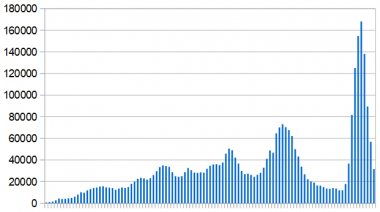Not to be sidelined amid Yemen’s growing mayhem (the Houthi rebellion alone has cost 338 civilian lives during the last 12 months according to government figures), al-Qaeda elements attacked a military vehicle in the eastern province of Marib on Thursday.
AFP says three soldiers died in the ambush and subsequent clashes, along with A'ed Saleh al-Shabwani, a wanted al-Qaeda figure. The Yemen Observer, however, quotes the governor of Marib as saying there were some injuries but no soldiers died. He also refused to confirm the killing of Shabwani. (This shows how difficult it can be in Yemen to get an accurate picture of what is going on.)
Yesterday the Christian Science Monitor had an article by Laura Kasinof explaining the country’s tribulations. It’s a good article but I don’t like the headline: “Why Yemen could become al-Qaeda haven”. Firstly, Yemen already is an al-Qaeda haven, and has been for years. Secondly, al-Qaeda is only one element. As the article rightly points out, the main problem is the state’s weakness in the face of multiple challenges to its authority. Unfortunately, American newspaper editors still seem fixated on al-Qaeda and unable to focus much beyond it.
An odd little report issued by the government news agency today claims that “the three destructive partners [the Houthi rebels, the southern secessionists and al-Qaeda] interconnect through direct links to destabilise Yemen”. This is based on an alleged statement by Tariq al-Fadhli, the self-appointed southern leader.
Fadhli was once an active jihadist, so it would not be surprising if he still maintained contacts with al-Qaeda. But the idea of collaboration between the Houthi rebels and al-Qaeda sounds totally implausible. The Houthi movement is shi’a and virulently opposed to Wahhabis and Salafis.
Posted by Brian Whitaker, 1 August 2009

 RSS Feed
RSS Feed

